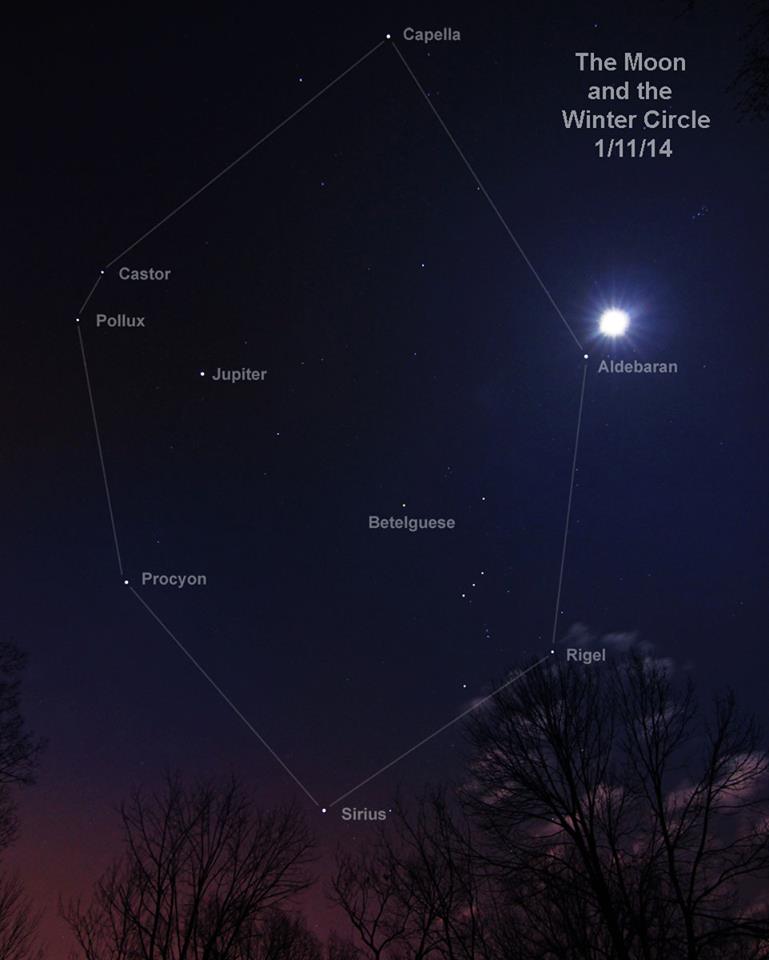
The chart above – for January 24, 25 and 26, 2021 – covers more area of sky than we typically show. It’s in answer to a reader in Nashville, who asked us to name the stars in the Winter Circle, a large asterism or noticeable pattern of stars, visible in the evening at this time of year.
We can do more than just name those stars. We can advise you to go outside on the dates specified above, and look for the waxing gibbous moon, then notice the stars nearby. The moon is within the Winter Circle stars on these dates. All the stars of the Winter Circle (sometimes called the Winter Hexagon) are first-magnitude stars – that is, among the brightest stars of the night sky – so they should be able to withstand tonight’s drenching moonlight.
The Winter Circle stars don’t form a perfect circle. Try starting at Capella and moving clockwise to Aldebaran, Rigel, Sirius, Procyon, Pollux, and Castor.
From our Northern Hemisphere locations, these same bright stars can be seen before dawn every late summer and early fall. And they can be seen in the evening every winter. Hence the name Winter Circle.
Are you familiar with the constellation Orion the Hunter? This brilliant constellation makes up the southwest corner of the Winter Circle. And Orion’s bright star Betelgeuse forms an equilateral triangle with the stars Sirius and Procyon, which we in the Northern Hemisphere call the Winter Triangle.
I wonder what these same stars are called in the Southern Hemisphere? They’re visible from there, but of course it’s summer there now. I don’t know if this particular collection of bright stars has some special name as seen from that part of the globe. If any of you do know … tell us in the comments!
Donate: Your support means the world to us

View larger. | This beautiful photo of the Winter Circle was taken on January 11, 2014, by EarthSky Facebook friend Duke Marsh in Indiana, when moon was near the star Aldebaran, and the planet Jupiter was in the vicinity of the Gemini stars, Castor and Pollux. Thank you, Duke.
Bottom line: The stars of the Winter Circle may be seen on these cold winter nights until well after midnight. On January 24, 25 and 26, 2021, the moon is inside the Winter Circle.
Read more about the Winter Circle: Brightest winter stars
Live by the moon with your 2021 EarthSky lunar calendar!
from EarthSky https://ift.tt/2N4NO0o

The chart above – for January 24, 25 and 26, 2021 – covers more area of sky than we typically show. It’s in answer to a reader in Nashville, who asked us to name the stars in the Winter Circle, a large asterism or noticeable pattern of stars, visible in the evening at this time of year.
We can do more than just name those stars. We can advise you to go outside on the dates specified above, and look for the waxing gibbous moon, then notice the stars nearby. The moon is within the Winter Circle stars on these dates. All the stars of the Winter Circle (sometimes called the Winter Hexagon) are first-magnitude stars – that is, among the brightest stars of the night sky – so they should be able to withstand tonight’s drenching moonlight.
The Winter Circle stars don’t form a perfect circle. Try starting at Capella and moving clockwise to Aldebaran, Rigel, Sirius, Procyon, Pollux, and Castor.
From our Northern Hemisphere locations, these same bright stars can be seen before dawn every late summer and early fall. And they can be seen in the evening every winter. Hence the name Winter Circle.
Are you familiar with the constellation Orion the Hunter? This brilliant constellation makes up the southwest corner of the Winter Circle. And Orion’s bright star Betelgeuse forms an equilateral triangle with the stars Sirius and Procyon, which we in the Northern Hemisphere call the Winter Triangle.
I wonder what these same stars are called in the Southern Hemisphere? They’re visible from there, but of course it’s summer there now. I don’t know if this particular collection of bright stars has some special name as seen from that part of the globe. If any of you do know … tell us in the comments!
Donate: Your support means the world to us

View larger. | This beautiful photo of the Winter Circle was taken on January 11, 2014, by EarthSky Facebook friend Duke Marsh in Indiana, when moon was near the star Aldebaran, and the planet Jupiter was in the vicinity of the Gemini stars, Castor and Pollux. Thank you, Duke.
Bottom line: The stars of the Winter Circle may be seen on these cold winter nights until well after midnight. On January 24, 25 and 26, 2021, the moon is inside the Winter Circle.
Read more about the Winter Circle: Brightest winter stars
Live by the moon with your 2021 EarthSky lunar calendar!
from EarthSky https://ift.tt/2N4NO0o

Aucun commentaire:
Enregistrer un commentaire